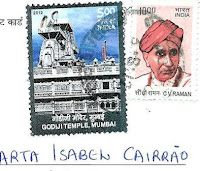All these cards are from indian Unesco sites new to my collection. The Champener card was sent by Sita and the other one, Chatrapathi Shivaji Terminus, was sent by Nagi.
Champaner-Pavagadh Archaeological Park is a UNESCO World Heritage Site which is located in Panchmahal district in Gujarat, India. It was inscribed in 2004.Champaner city was built by Sultan Mehmood Shah Begara of Gujrat There is a concentration of largely unexcavated archaeological, historic and living cultural heritage properties cradled in an impressive landscape which includes prehistoric (chalcolithic) sites, a hill fortress of an early Hindu capital, and remains of the 16th century capital of the state of Gujarat. The site also includes, among other vestiges, fortifications, palaces, religious buildings, residential precincts, agricultural structures and water installations, from the 8th to the 14th centuries. The Kalikamata Temple on top of the Pavagadh Hill is considered to be an important shrine, attracting large numbers of pilgrims throughout the year. The site is the only complete and unchanged Islamic pre-Mughal city.
Champaner-Pavagadh is perhaps the most authentic medieval city in India as all the information about the original city is available below the ground. - in: wikipedia
Photo by V. B. Anand
The Chhatrapati Shivaji Terminus, formerly known as Victoria Terminus Station, in Mumbai, is an outstanding example of Victorian Gothic Revival architecture in India, blended with themes deriving from Indian traditional architecture. The building, designed by the British architect F. W. Stevens, became the symbol of Bombay as the ‘Gothic City’ and the major international mercantile port of India. The terminal was built over 10 years, starting in 1878, according to a High Victorian Gothic design based on late medieval Italian models. Its remarkable stone dome, turrets, pointed arches and eccentric ground plan are close to traditional Indian palace architecture. It is an outstanding example of the meeting of two cultures, as British architects worked with Indian craftsmen to include Indian architectural tradition and idioms thus forging a new style unique to Bombay. - in: http://whc.unesco.org/en/list/945
.jpg)


.jpg)
No comments:
Post a Comment